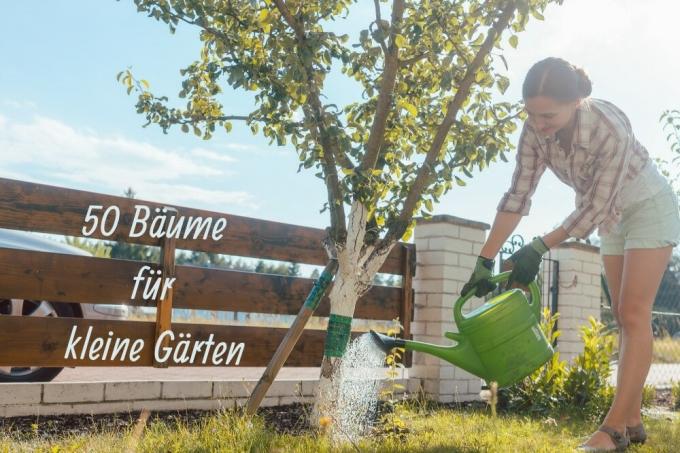
table of contents
- Small trees / dwarf trees
- Trees with a spherical crown
- Small trees with an overhanging / umbrella-shaped crown
- Columnar trees
- frequently asked Questions
A tree belongs in every garden. But what if the garden is small and doesn't have too much space? In this ultimate list, you will find 50 different species and strains that are great for small gardens.
In a nutshell
- Dwarf trees or even large shrubs that are grown or trunks fit very well in small gardens. were refined
- Ball trees are ideal, as there is a large selection of small and compact varieties
- Column-shaped trees take up little space, but can also grow taller
- Forms of education such as the trellis are very space-saving
- Always pay attention to the right location and soil so that the small trees in the garden can thrive
Small trees / dwarf trees
Some tree species are naturally small, so you can do them without regular pruning can easily be planted in a small garden or front yard - they will only take up little space with age to need.
Tip: The trellis shape is a space-saving form of tree culture, with which you can not only like fruit trees Cultivate apples, pears, peaches or quinces, but also many deciduous trees in a confined space can.
American dogwood (Cornus florida)
One of the most beautiful for small gardens, robust due to the grafting on Cornus kousa and especially wonderful to look at in the flowering period.
- Location: sun to partial shade
- Soil: containing humus, acidic to neutral
- Height: up to three meters
- Flowers: long-lasting, very lush pink flowers from late May to June
- Leaves: summer green, red autumn colors
- Special features: hardy
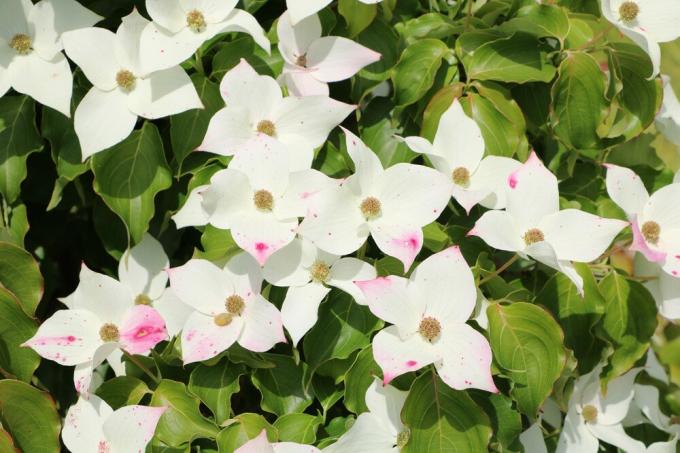
Mountain cherry (Prunus sargentii)
With an annual increase of 20 to 30 centimeters, the mountain cherry grows rather slowly, so it can also be planted in small gardens. Note, however, that it can become quite wide with age and therefore needs a single position.
- Location: sun
- Soil: prefers heavy soils
- Height: up to ten meters
- Spread: up to eight meters
- Flowers: April, pink flowers
- Fruits: small ornamental cherries, black-red
- Leaves: summer green, red autumn colors
- Special features: hardy, for single use
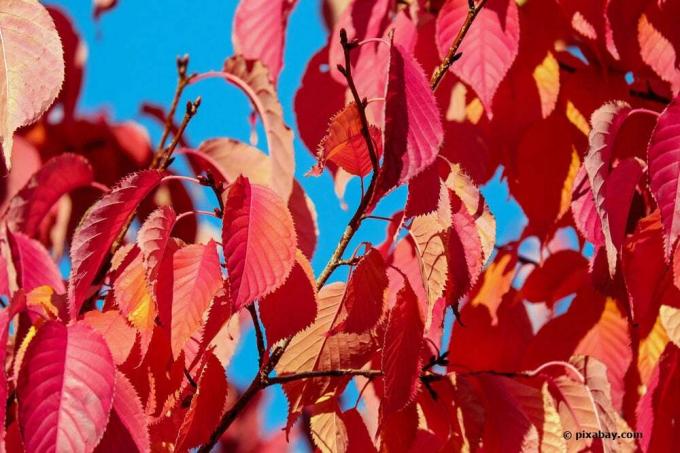
Bubble tree (Koelreuteria paniculata)
With a growth rate of around 20 centimeters, the bubble tree grows rather slowly. It remains compact even in old age and is very suitable for small plots in the city.
- Location: sunny
- Soil: well drained, rather dry
- Height: up to eight meters
- Spread: up to five meters
- Flowers: yellow panicle flowers between July and August
- Fruits: decorative fruits, not edible
- Leaves: deciduous
- Special features: tolerates heat very well

Flower ash (Fraxinus ornus)
The attractive flower ash, also known as manna ash, is well suited for dry soils.
- Location: sun to partial shade
- Soil: normal garden soil
- Height: up to ten meters
- Spread: up to five meters
- Flowers: creamy white panicle flowers, May to June
- Leaves: summer green, yellow autumn color
- Special features: valuable nutrient wood for bees
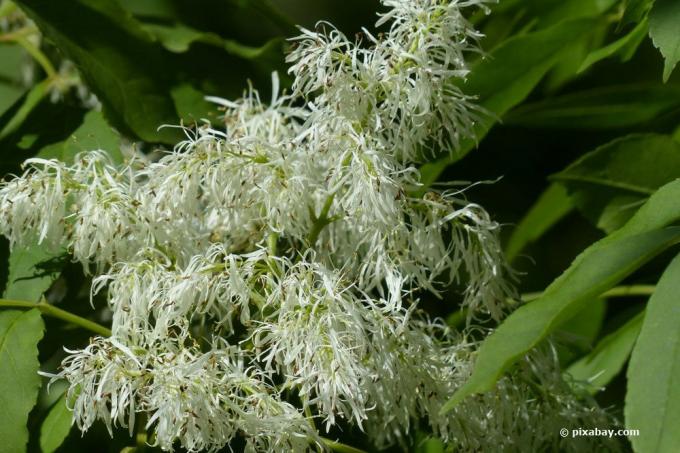
Vinegar tree (Rhus typhina)
The vinegar tree is also known as deer cob sumac. It forms attractive, inedible fruits that stay on the tree all winter.
- Location: sunny
- Soil: permeable, no waterlogging
- Height: up to six meters
- Spread: up to six meters
- Flowers: large, greenish panicle flowers between June and July
- Fruits: red fruit cobs
- Leaves: deciduous, bright red autumn colors
- Special features: poisonous for humans and animals

Lilac (Syringa vulgaris)
Lilac initially grows like a bush at a young age, but later forms one or more stems. Very suitable for small gardens and front gardens, also as a privacy screen.
- Location: sunny to partial shade
- Soil: normal, deep garden soil
- Height: up to approx. four meters
- Spread: up to approx. two metres
- Flowers: white or purple panicle flowers, strongly fragrant, mid-May to early June
- Leaves: deciduous
- Special features: can be planted well in groups
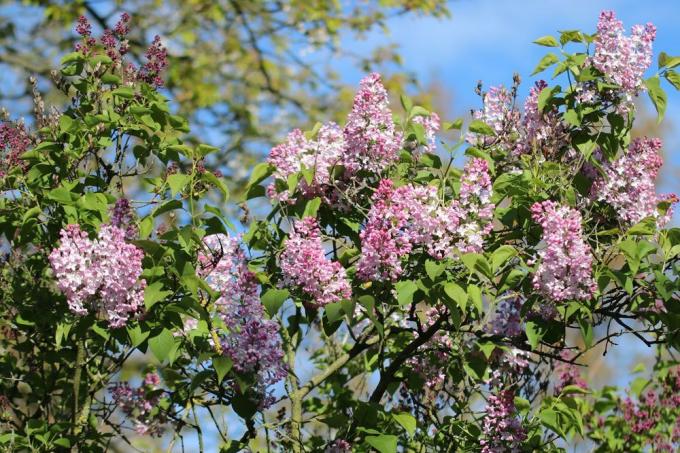
Common Judas Tree (Cercis siliquastrum)
The common Judas tree naturally grows as a large shrub, but can be cultivated as a small tree on a half or high trunk through consistent pruning or grafting.
- Location: sunny to partially shaded
- Soil: normal garden soil
- Height: up to six meters
- Spread: up to four meters
- Flowers: simple, purple-pink flowers between April and May
- Fruits: decorative fruits
- Leaves: deciduous
- Special features: well suited for dry soils
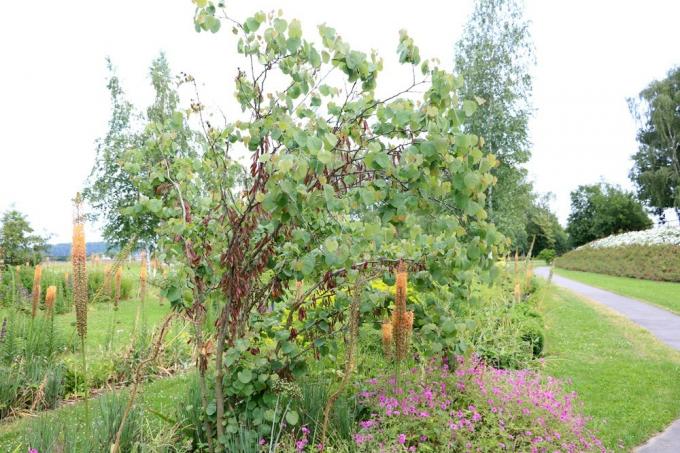
Laburnum(Laburnum watereri 'Vossii')
The noble laburnum variety 'Vossii' is particularly rich in bloom and adorns both small gardens and front gardens. It is best to plant them individually.
- Location: sunny to partially shaded
- Soil: well drained, fresh garden soil
- Height: up to five meters
- Spread: up to four meters
- Blossom: golden yellow grape blossoms, late May to June
- Fruits: yes
- Leaves: deciduous
- Special features: highly poisonous
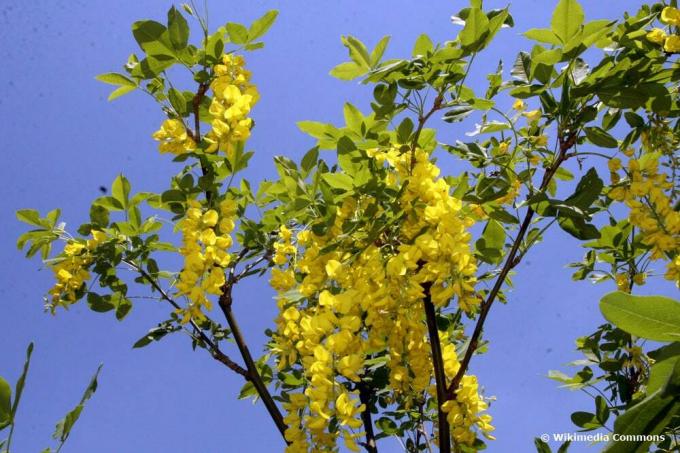
Japanese maple (Acer japonicum)
This species, also known as monkshood maple, is similar to the better-known Japanese maple, but the leaves are less finely slit. There are many beautiful varieties for small gardens such as the loosely bushy 'Aconitifolium'.
- Location: sun to partial shade
- Soil: rich in humus, well drained, no lime
- Height: up to five meters
- Spread: up to five meters
- Blossom: simple grape blossoms, purple with a yellow center, April to May
- Fruits: yes
- Leaves: deciduous, bright red autumn colors
- Special features: excellent bee pasture

Japanese cherry (Prunus serrulata 'Royal Burgundy')
This species also grows rather like a shrub by nature, but can be grafted onto a half or standard trunk. be educated accordingly through cutting measures.
- Location: sun to partial shade
- Soil: deep
- Height: up to seven meters
- Spread: up to five meters
- Flowers: dark pink umbels, end of April to May
- Leaves: purple-red, deciduous
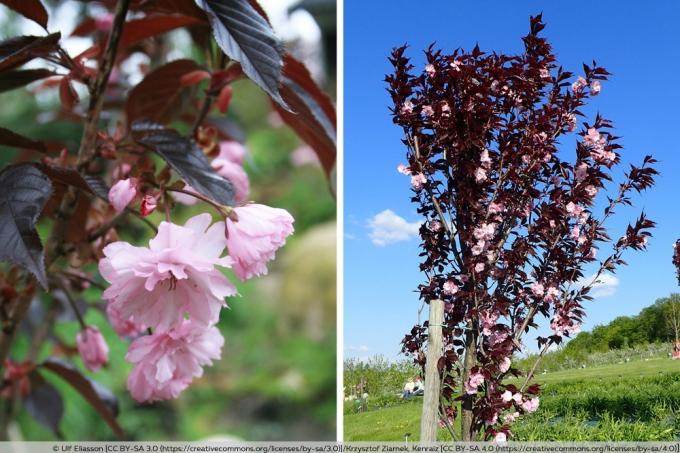
Canadian Judas Tree (Cercis canadensis 'Forest Pansy')
The Judas tree is a beautiful, easy-care and very robust tree with a loose habit. Well suited as a solitary in not-so-small gardens.
- Location: sun to partial shade
- Soil: normal garden soil, if possible loamy, permeable
- Height: up to eight meters
- Spread: up to eight meters
- Flower: pink, March to April
- Leaves: red, deciduous
- Special features: also suitable for keeping in a bucket
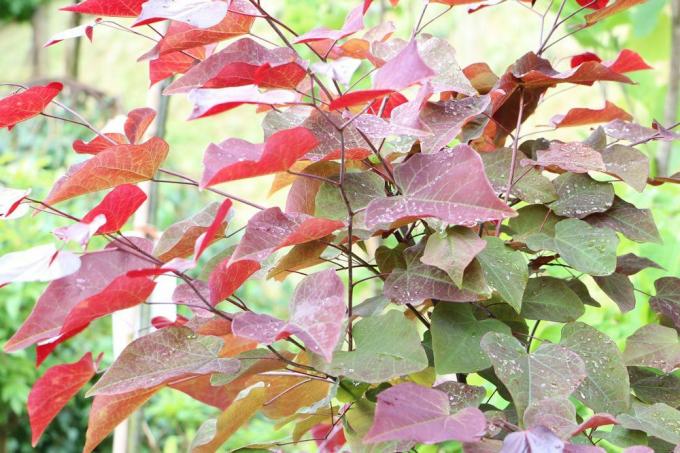
Cake tree (cercidiphyllum japonicum)
A beautiful specimen tree for small gardens, also known as a gingerbread tree or katsura tree. The leaves have an intense smell of cinnamon.
- Location: sun to partial shade
- Soil: rich in nutrients
- Height: up to ten meters
- Spread: up to seven meters
- Flowers: carmine red, April
- Leaves: summer green, red autumn colors
- Special features: well suited for keeping pots
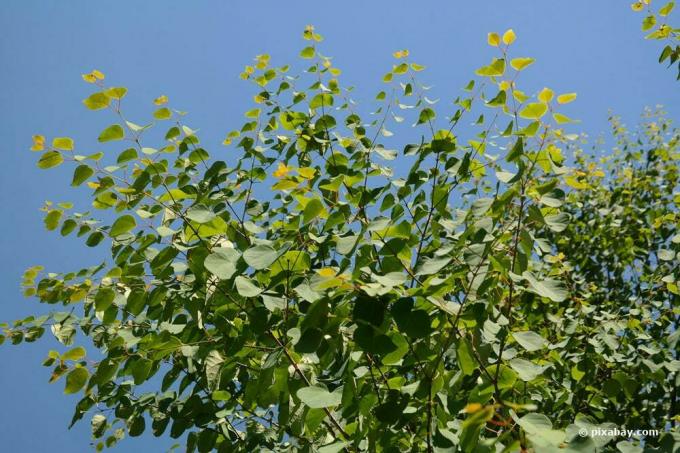
Magnolias (Magnolia)
Magnolias, with their lavish blooms and small but bizarre growth, are just the right choice for small gardens. There are many beautiful species and varieties, but the tulip magnolia (Magnolia x soulangeana) is particularly attractive.
- Location: Sun, partial shade to light shade
- Soil: rich in humus, acidic pH
- Height: up to eight meters
- Spread: up to nine meters
- Flowers: large cupped flowers, white or pink, early April to May
- Leaves: deciduous
- Special features: well hardy
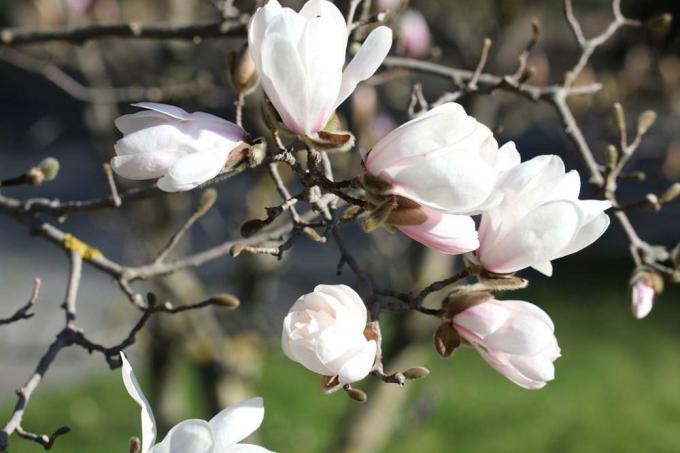
Pagoda dogwood (Cornus controversa)
In addition to the species, there are also attractive varieties with colorful foliage ('Variegata'). These trees fit well as solitaires in small gardens.
- Location: sun to partial shade
- Soil: permeable, acidic to neutral pH
- Height: up to eight meters
- Spread: up to five meters
- Flowers: white panicles, early June to mid-July
- Leaves: deciduous
- Special features: layer-like growth
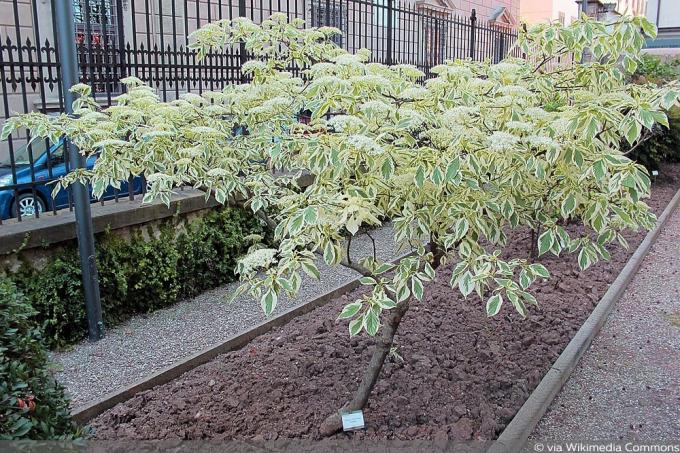
False beech (Nothofagus antarctica)
Tolerates both urban climates and soils close to the groundwater, very well suited for difficult locations.
- Location: sunny to partially shaded
- Soil: normal garden soil
- Height: up to ten meters
- Spread: up to six meters
- Flowers: greenish yellow, inconspicuous, May
- Leaves: deciduous, yellow autumn color
- Special features: very robust and hardy
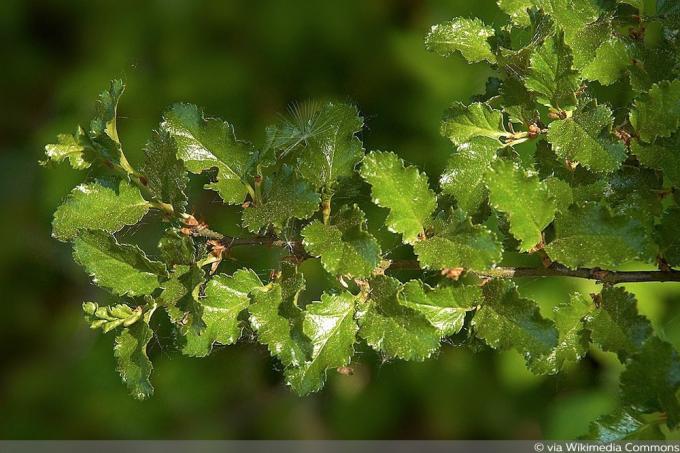
Wild apple (Malus sylvestris)
Also known as crab apple, a valuable, indigenous nutrient wood for insects and birds.
- Location: sunny to partially shaded
- Soil: undemanding, rich in nutrients
- Height: up to six meters
- Spread: up to four meters
- Flowers: white-pink, April to May
- Fruits: small apples
- Leaves: deciduous
- Special features: well suited for mixed plantings and hedges
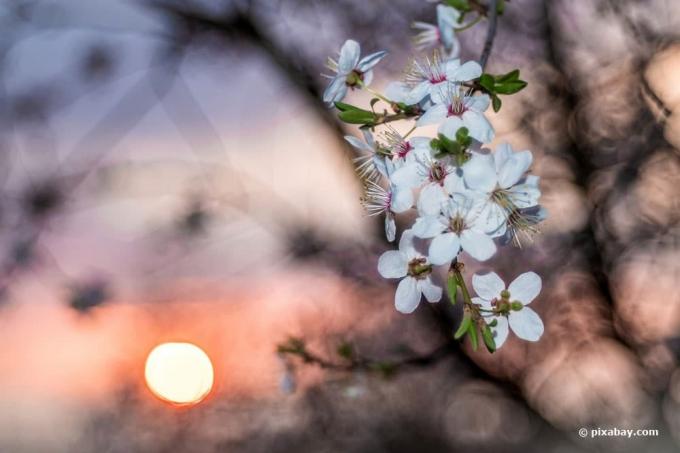
Tip: Suitable trees for small gardens can often be found among the various wild and ornamental fruit species. Especially with wild fruits, the fruits are often edible or usable (e.g. for preserving or making jam).
Dwarf birch (Betula nana)
This species, also known as arctic birch, is widespread in Scandinavia. It is ideal for small gardens, but does not tolerate heat.
- Location: sunny to partially shaded
- Soil: like bog or peat soil, otherwise normal garden soil
- Growth height: up to 120 centimeters
- Spread: up to 120 centimeters
- Flowering: April to May
- Leaves: summer green, yellow autumn color
- Special features: tolerates extreme cold
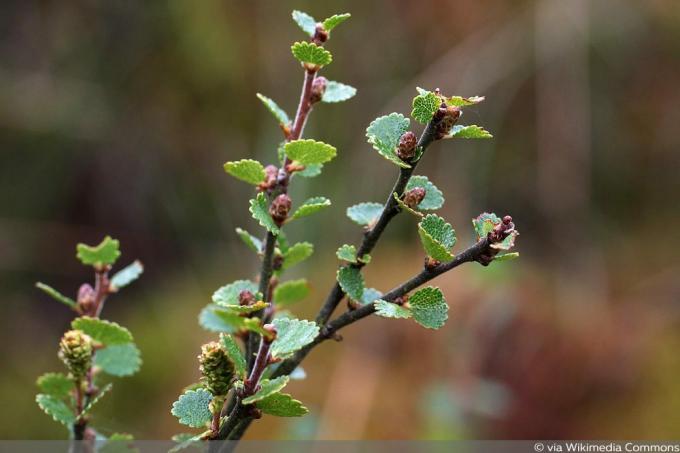
Trees with a spherical crown
So-called spherical trees are perfect for small gardens, as they naturally remain small and compact. But be careful: Not all of the species and varieties presented here naturally form a spherical crown, with some you have to keep it in shape with regular pruning. In return, however, you can look forward to a beautiful house tree.
Blood plum (Prunus cerasifera 'Nigra')
Can be cultivated both as a large shrub and as a tree with consistent pruning.
- Location: sunny to partially shaded
- Soil: undemanding
- Height: up to four meters
- Spread: up to five meters
- Flowers: pink cup-shaped flowers, April
- Fruits: edible
- Leaves: dark red, deciduous
- Special features: tolerates drought
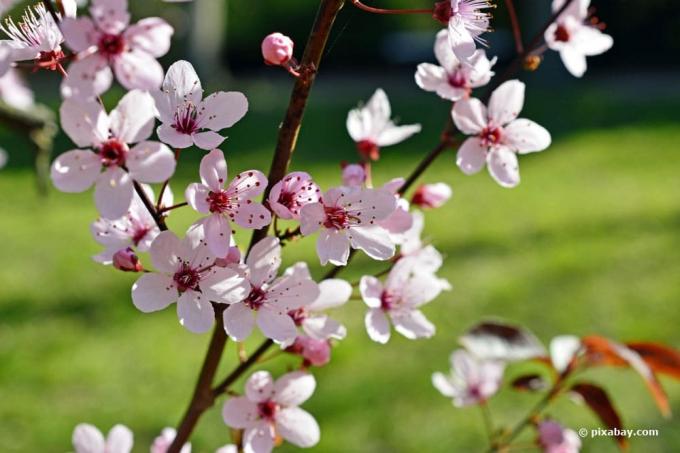
Ball maple (Acer globosum)
- Location: sunny to partially shaded
- Soil: normal garden soil
- Growth height up to six meters
- Spread: up to six meters
- Flowers: yellowish green, inconspicuous, April
- Leaves: summer green, golden yellow autumn color
- Special features: straight trunk, attractive foliage
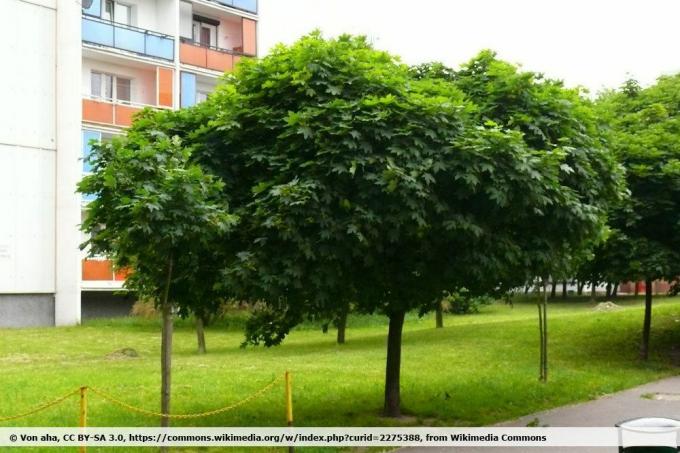
Ball sweet gum (Liquidambar styraciflua 'Gum Ball')
- Location: sunny
- Soil: rich in humus, slightly acidic pH
- Height: up to five meters
- Spread: up to four meters
- Flowers: green spike flowers, May
- Leaves: deciduous
- Special features: densely branched
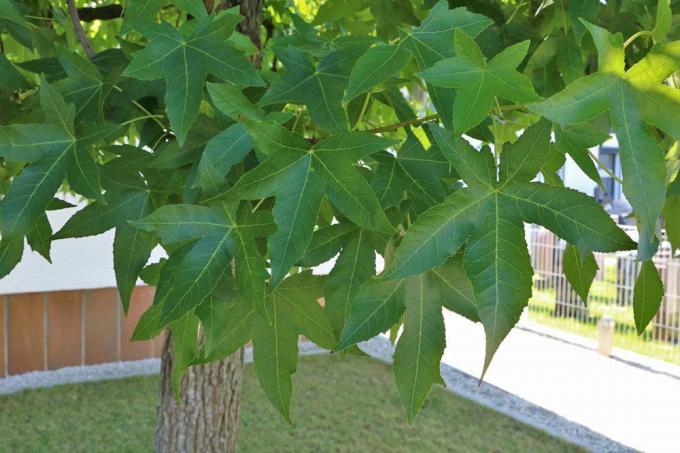
Ball-flower ash (Fraxinus ornus 'Meczek')
- Location: sunny to partially shaded
- Soil: fresh to moist, deep
- Height: up to eight meters
- Spread: up to four meters
- Flowers: creamy white panicle flowers, fragrant, beginning of May to end of June
- Leaves: deciduous
- Special features: very robust
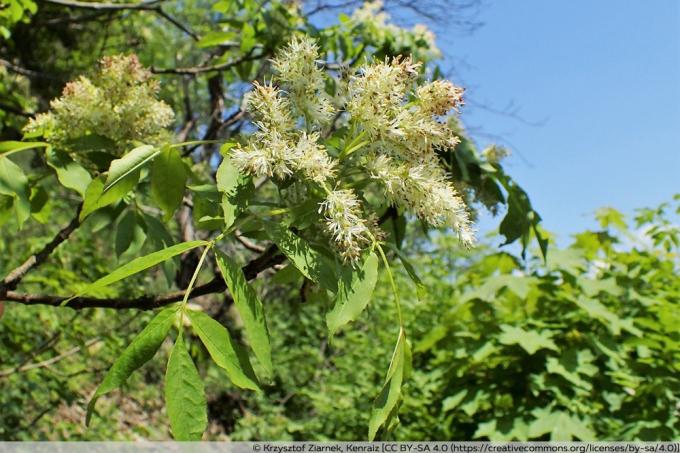
Ball field maple (Acer campestre 'Nanum')
Often offered as a standard grafting, it is a small, very compact growing tree with a tightly closed crown. Very suitable for small gardens.
- Location: sunny to partially shaded
- Soil: well drained, rich in humus
- Height: up to three meters
- Spread: up to three meters
- Flowering: intense
- Leaves: deciduous, golden yellow autumn color
- Special features: valuable bee pasture
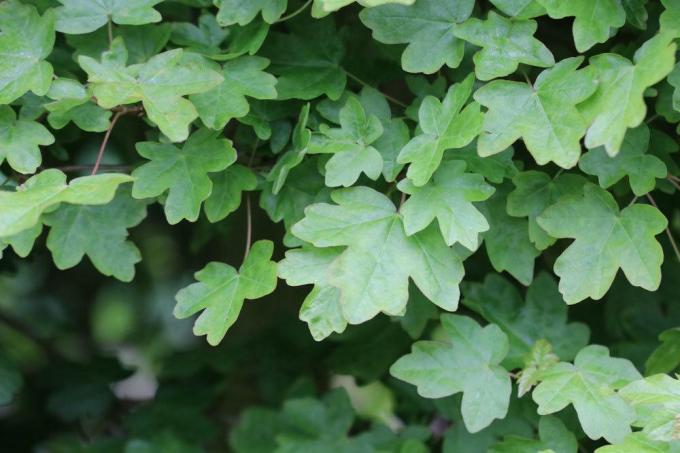
Tip: If you come across trees or shrubs with the variety designation 'Nana' or 'Nanum', this is always an indication of the growth behavior: These are always small.
Ball rock pear (Amelanchier arborea 'Robin Hill')
It is a narrow, upright small tree.
- Location: sunny to partially shaded
- Soil: normal garden soil
- Height: up to eight meters
- Spread: up to five meters
- Flowers: white, profuse, April to May
- Leaves: deciduous
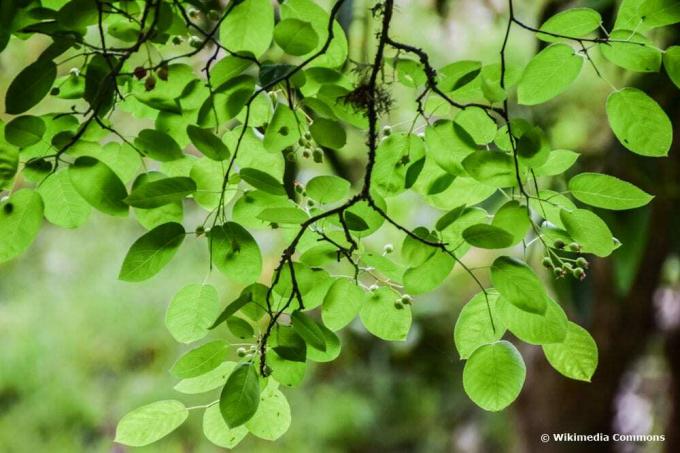
Ball ginkgo (Ginkgo biloba 'Mariken')
This dwarf tree fits in every garden - no matter how small it is.
- Location: sunny to partially shaded
- Soil: rich in humus
- Growth height: up to 150 centimeters
- Spread: up to 150 centimeters
- Leaves: deciduous
- Special features: very good for keeping pots and small gardens

Globe plane tree (Platanus hispanica 'Alphens Globe')
- Location: sunny to partially shaded
- Soil: nutrient-rich, loamy
- Height: up to five meters
- Spread: up to five meters
- Leaves: deciduous, yellow autumn color
- Special features: beautiful house tree for small gardens

Kugelrobinie (Robinia pseudoacacia 'Umbraculifera')
This variety, also known as ball acacia, develops a dense, well-branched crown. It tolerates pruning well, but should be planted as a solitary.
- Location: sunny
- Soil: nutrient-rich, well-drained
- Height: up to five meters
- Spread: up to five meters
- Leaves: deciduous
- Special features: warmth-loving, poisonous
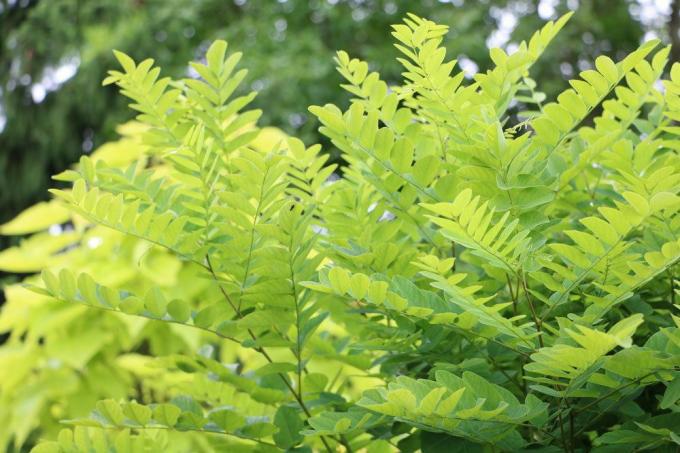
Globe steppe cherry (Prunus fruticosa 'Globosa')
- Location: sunny to partially shaded
- Soil: rich in humus, calcareous
- Height: up to three meters
- Spread: up to three meters
- Flowers: white, April to May
- Fruits: pea-sized cherries, edible
- Leaves: deciduous
- Special features: very heat-tolerant, hardy, undemanding, well-suited city tree
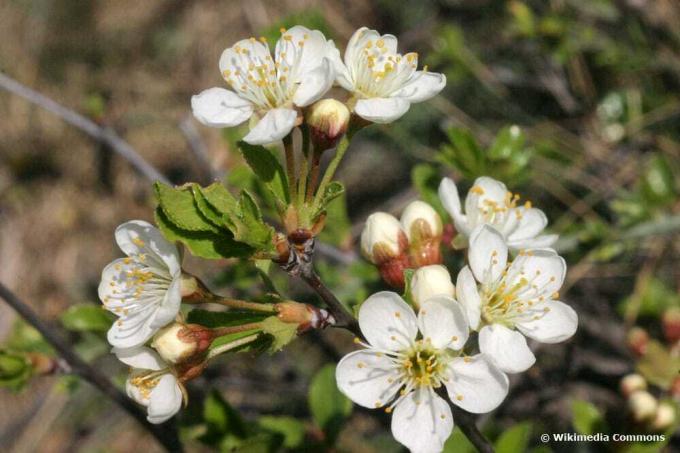
Round Marsh Oak (Quercus palustris 'Green Dwarf')
- Location: sunny to partially shaded
- Soil: nutrient-rich, well-drained, no lime
- Height: up to three meters
- Spread: up to two meters
- Blossom: golden yellow umbels, May
- Leaves: deciduous, bright yellow autumn colors
- Special features: very good for small gardens and narrow locations
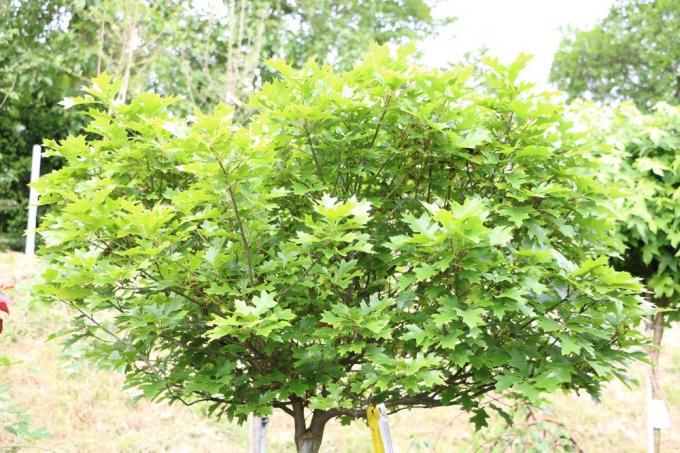
Ball trumpet tree (Catalpa bignonioides 'Nana')
- Location: sunny to partially shaded
- Soil: nutrient-rich, well-drained
- Height: up to three meters
- Spread: up to three meters
- Leaves: deciduous, yellow autumn color
- Special features: no flowers or fruits
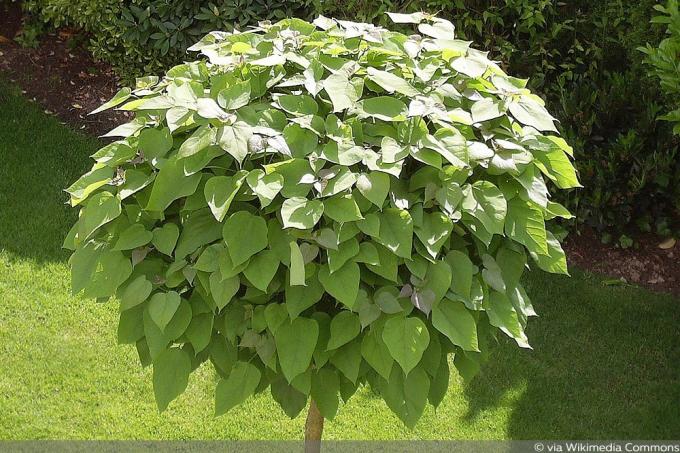
Ball winter linden (Tilia cordata 'Green Globe')
- Location: sunny to partially shaded
- Soil: adaptable
- Height: up to eight meters
- Spread: up to three meters
- Flowers: yellowish-white, strongly fragrant, June
- Fruits: small nuts
- Leaves: deciduous, yellow autumn leaves
- Special features: valuable wood for bees

Hawthorn (Crataegus laevigata 'Paul's Scarlet')
- Location: sunny to partially shaded
- Soil: nutrient-rich, loamy
- Height: up to six meters
- Spread: up to approx. three meters
- Blossom: dark red, May to June
- Leaves: deciduous, beautiful autumn colors
- Special features: wood for protection against birds
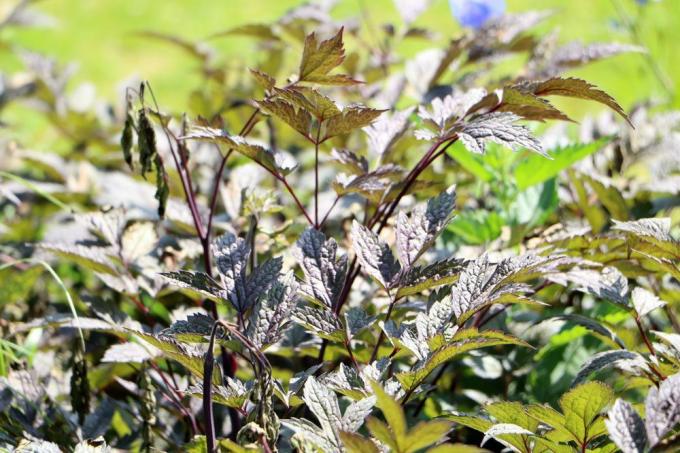
Evergreen olive willow (Elaeagnus × ebbingei)
Regarding its location, the wintergreen olive willow is extremely robust and adaptable. It can be grown as a shrub or as a small tree.
- Location: partial shade to light shade
- Soil: normal garden soil
- Height: up to three meters
- Spread: up to three meters
- Flowers: white, fragrant, October to November
- Leaves: evergreen
- Special features: very suitable for hedges and tubs
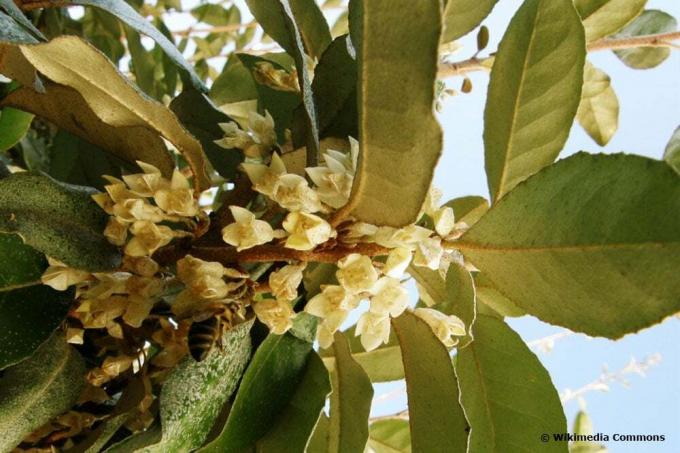
Small trees with an overhanging / umbrella-shaped crown
So-called “forms of mourning” in trees have a romantic effect and are an eye-catcher in every garden - even in small ones. These species and varieties even fit in the front yard.
Japanese maple (Acer palmatum)
One of the most famous ornamental maples for small gardens. The trees from Japan are not only very popular in Asian-style gardens, they also go well with the garden pond. There are many appealing varieties, the red-leaved variety 'Atropurpureum' is particularly popular.
- Location: sun to partial shade
- Soil: fresh to moist, but well-drained
- Height: up to four meters
- Spread: up to four meters
- Flowering: inconspicuous, May to June
- Leaves: dark red, bright red autumn colors
- Special features: is best shown to advantage in individual positions
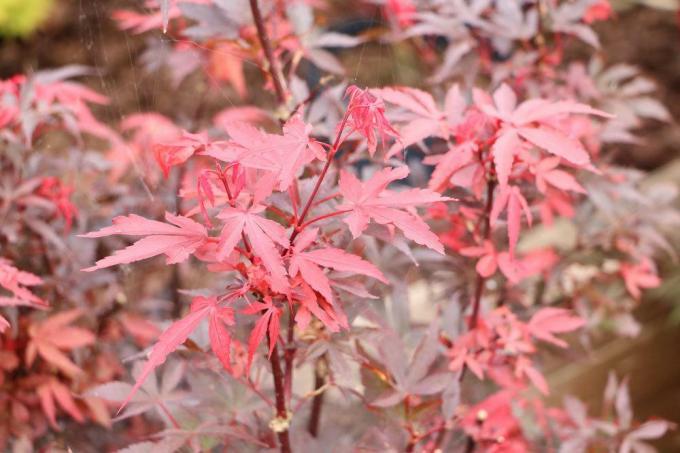
Gold Gleditschia (Gleditsia triacanthos 'Sunburst')
- Location: sunny
- Soil: nutrient-rich, moist
- Height: up to ten meters
- Spread: up to six meters
- Flower: white, June
- Leaves: deciduous
- Special features: hardy and very robust
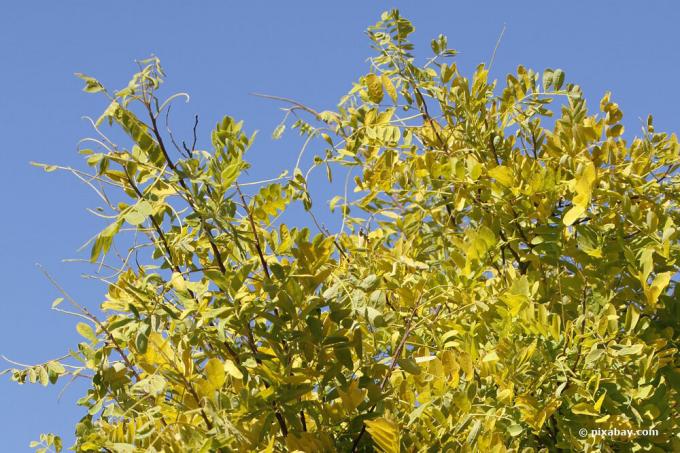
Silver birch (Betula pendula 'Youngii')
- Location: sunny to partially shaded
- Soil: normal garden soil
- Height: up to seven meters
- Spread: up to four meters
- Flowering: inconspicuous, March to April
- Leaves: deciduous, yellow autumn color
- Special features: also known as weeping birch

Hanging kitten willow (Salix caprea 'Pendula')
- Location: sunny to partially shaded
- Soil: very adaptable, grows almost anywhere
- Height: up to approx. two metres
- Spread: up to 150 centimeters
- Flowers: yellowish white catkins, March to April
- Deciduous leaves, yellowish autumn colors
- Special features: very nice as a solitaire on lawns
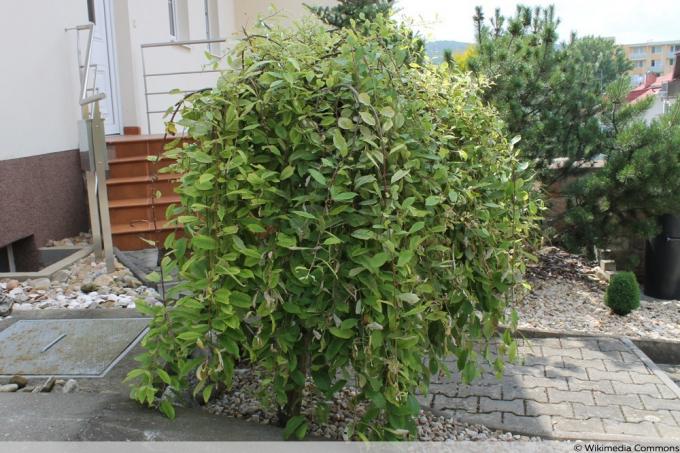
Hanging mulberry (Morus nigra 'Pendula')
The variety is also known as the black mulberry. It is a special form of the white mulberry.
- Location: sunny and warm
- Soil: dry, calcareous
- Height: up to six meters
- Spread: up to four meters
- Flowering: inconspicuous, May to June
- Fruits: black red berries
- Leaves: deciduous, yellow autumn color
- Special features: good heat tolerance, winter protection advisable
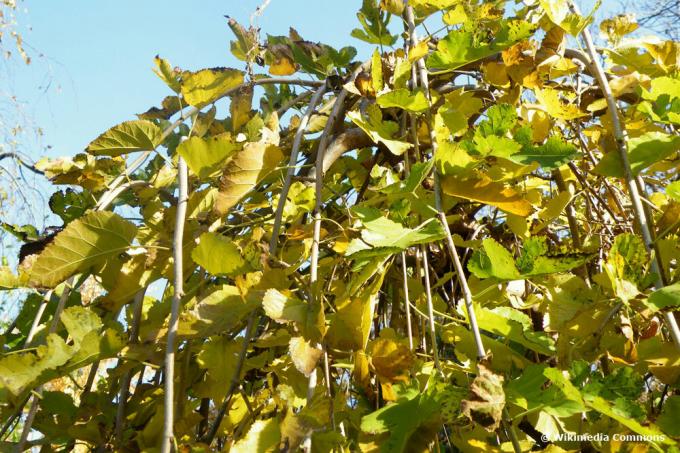
Hanging common beech (Fagus sylvatica 'Purple Fountain')
- Location: sun to shade
- Soil: rich in nutrients, calcareous
- Height: up to eight meters
- Spread: up to four meters
- Flowering: May
- Leaves: black-red, deciduous
- Special features: is best shown to advantage in individual positions

Hanging pagoda tree (Sophora japonica 'Pendula')
- Location: sunny
- Soil: well drained
- Height: up to eight meters
- Spread: up to eight meters
- Blossom: yellowish white grape blossoms, July to August
- Fruits: elongated legumes, not suitable for consumption
- Leaves: deciduous, yellow autumn color
- Special features: attractive solitary tree for small gardens

Ornamental pear (Pyrus salicifolia 'Pendula')
This attractive variety of wild pear is also known as willow-leaved pear. It grows like a bush, but can also be grown as a stem.
- Location: sunny
- Soil: well drained, dry
- Height: up to six meters
- Spread: up to four meters
- Flowering: April to May
- Fruits: the size of an olive, not edible
- Leaves: deciduous, strong yellow autumn color
- Special features: location tolerant
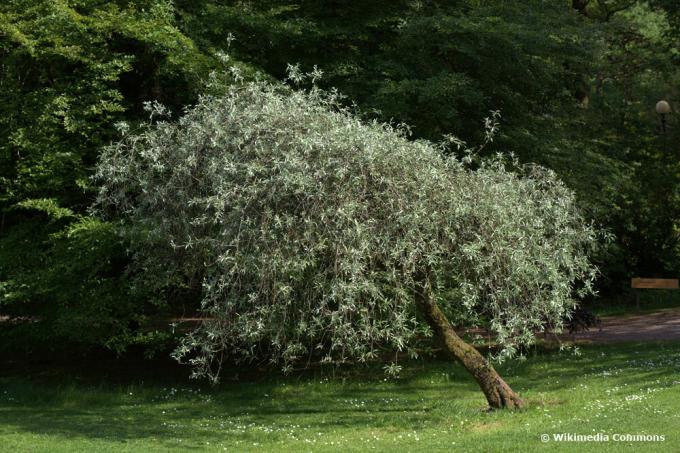
Japanese clove cherry (Prunus serrulata 'Kiku-shidare-Zakura')
- Location: sunny
- Soil: deep, loose, calcareous
- Height: up to five meters
- Spread: up to approx. five meters
- Flowers: dark pink umbels, end of April to May
- Leaves: deciduous
- Special features: grows heavily overhanging, especially at a young age
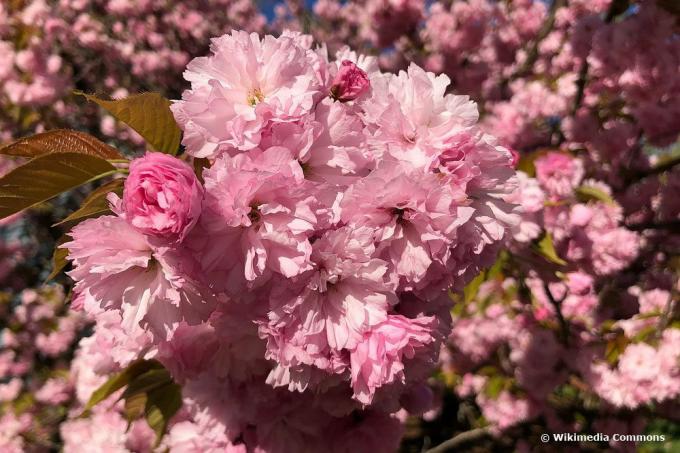
Copper rock pear (Amelanchier lamarckii)
- Location: sun to partial shade
- Soil: normal garden soil
- Height: up to six meters
- Spread: up to six meters
- Flowers: white grape blossoms, April
- Leaves: deciduous, beautiful autumn colors
- Special features: bee-friendly
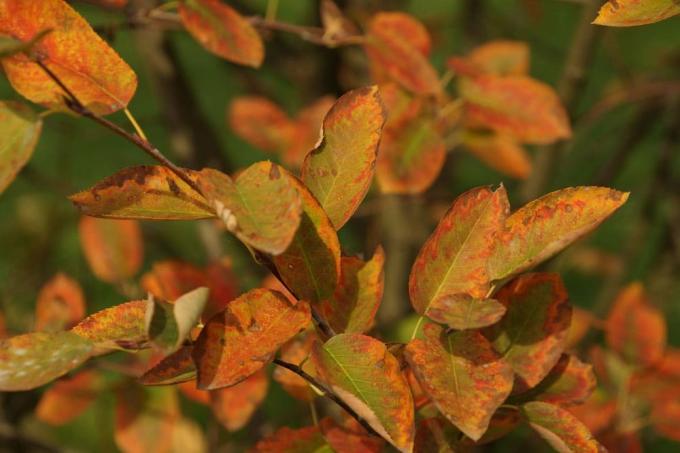
Columnar trees
The column shape offers the invaluable advantage that the trees can be very tall - but still remain narrow in their diameter.
Tip: If you have a small garden and still want to harvest fruit, you can use columnar fruit trees. Whether apple, pear, cherry or plum - there is something for every taste.
Yellow column beech (Fagus sylvatica 'Dawyck Gold')
- Location: sunny to shade
- Soil: fresh to moist, rich in humus
- Height: up to eight meters
- Spread: remains narrow
- Flowering: inconspicuous, May
- Fruits: beechnuts
- Leaves: deciduous
- Special features: slow-growing, grows very slowly
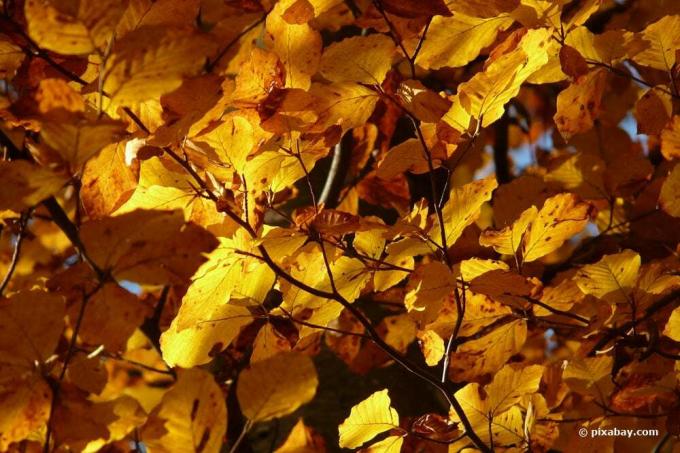
Red column beech (Fagus sylvatica 'Rohan Obelisk')
- Location: sunny
- Soil: rich in humus, slightly calcareous
- Height: up to eight meters
- Spread: remains narrow, up to three meters
- Flowering: inconspicuous, June
- Fruits: beechnuts
- Leaves: red, deciduous, reddish brown autumn color
- Special features: grows very slowly

Column beech (Fagus sylvatica 'Dawyck')
- Location: sunny to shade
- Soil: nutrient-rich, fresh to moist
- Height: up to 25 meters
- Spread: remains very narrow, up to three meters
- Fruits: beechnuts
- Leaves: deciduous
- Special features: very good shade tolerance
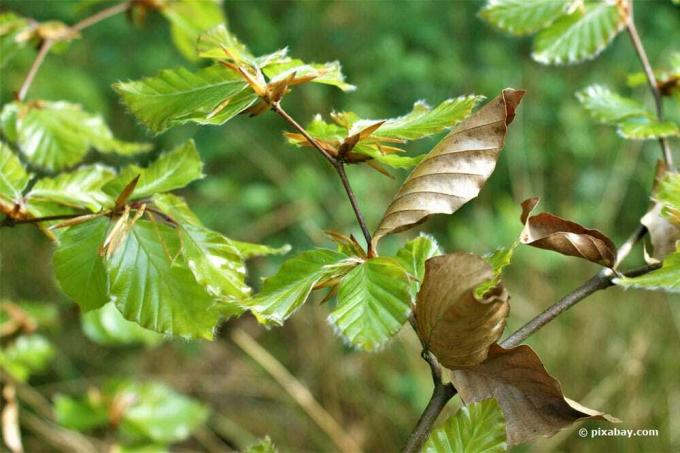
Columnar mountain ash (Sorbus aucuparia 'Fastigiata')
- Location: sunny to partially shaded
- Soil: rich in humus, loose, slightly acidic
- Height: up to seven meters
- Spread: up to four meters
- Flowers: white umbels, May to June
- Fruits: bright red, the size of a pea, not edible
- Leaves: deciduous
- Special features: valuable wood for birds
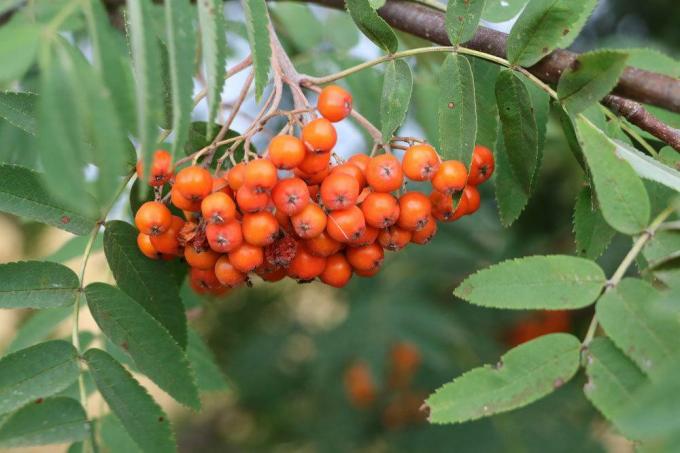
Pillar rock pear (Amelanchier alnifolia 'Obelisk')
- Location: sunny to partially shaded
- Soil: normal garden soil
- Height: up to five meters
- Spread: up to approx. three meters
- Flowers: white, April to May
- Fruits: edible
- Leaves: deciduous, yellow to red autumn colors
- Special features: valuable wood for birds
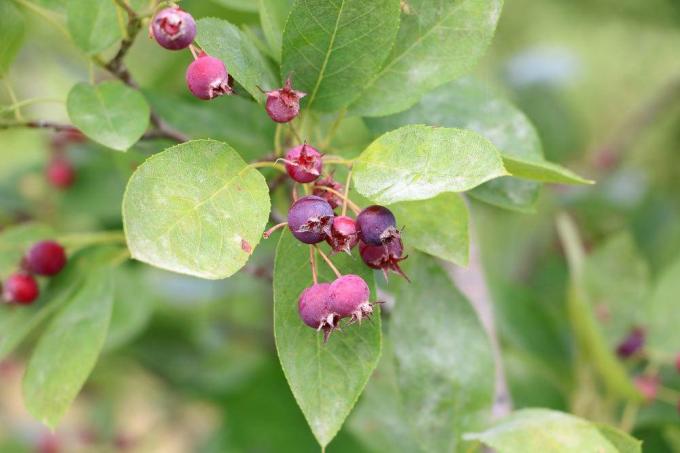
Column juniper (Juniperus communis 'Sentinel')
There are not too many evergreen trees for small gardens, so the low and very narrow columnar juniper is a good choice, especially since the variety is very robust and undemanding.
- Location: sunny to partially shaded
- Soil: normal garden soil
- Height: up to three meters
- Spread: up to 50 centimeters
- Flower: yellow
- Leaves: evergreen
- Special features: easy to care for, very robust, well suited for keeping in a bucket

Columns-Ornamental cherry (Prunus serrulata 'Amanogawa')
- Location: sunny to partially shaded
- Soil: rich in humus, well drained, calcareous
- Height: up to five meters
- Spread: up to approx. 2.5 meters
- Flowers: light pink umbels, April to May
- Leaves: deciduous
- Special features: also very suitable for narrow gardens
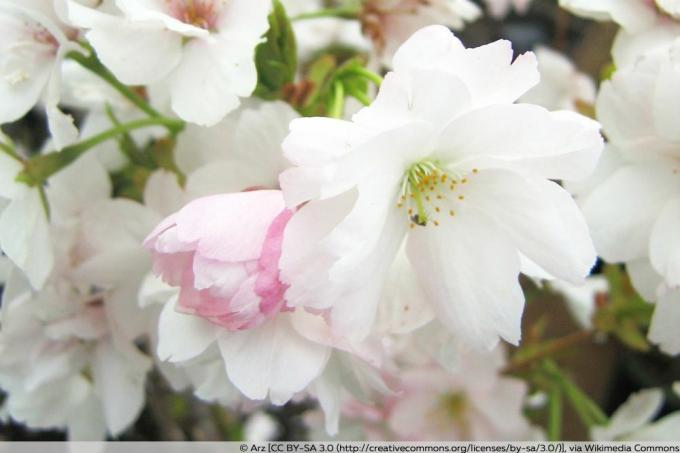
Poplar poplar (Populus tremula 'Erecta')
- Location: sunny to partially shaded
- Soil: normal garden soil, grows almost everywhere
- Height: up to 15 meters
- Spread: up to four meters
- Flower: yellowish catkins
- Leaves: deciduous, yellow autumn leaves
- Special features: adaptable and undemanding

frequently asked Questions
If you are looking for a small, evergreen tree for the garden, it is best to look around at the conifers. Recommended are u. a. the spherical pine 'pug', which, however, does not form a trunk and forms a bush ball up to one and a half meters high. The spherical cork fir 'Green Globe' remains small with a height of up to two meters, as does the dwarf arborvitae 'Tiny Tim' with a maximum height of one meter.
Beech, yew, linden and various types of maple are considered to be particularly shade-tolerant. However, these trees get immensely large, so they are not suitable for small gardens, you can however, about special varieties that remain rather small or narrow, such as the columnar beech 'Dawyck' decide. This too is up to 25 meters high, but remains rather narrow with a diameter of around three meters.
Very fast-growing small trees are the vinegar tree as well as mountain ash and Japanese ornamental cherries.
